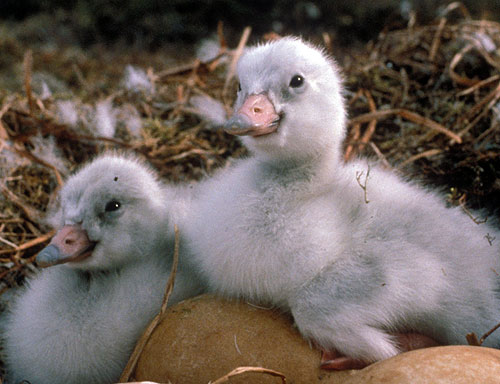
More news on bird noses
March 13, 2012
"Every bird that’s been studied has a sense of smell,” said Julie Hagelin, a biologist at the University of Alaska Fairbanks who has pondered that overlooked ability in birds for years.
Tundra swans like these Southwest Alaska hatchlings and other birds might be using their noses to process more of their worlds than biologists previously thought.
Smelling might be quite significant for some birds, according to Paul Ehrlich, David Dobkin and Darryl Wheye, co-authors of the Birder’s Handbook: “Kiwis, the flightless birds that are the national symbol of New Zealand, appear to sniff out their earthworm prey. Sooty shearwaters and northern fulmars are attracted from downwind to the smell of fish oils, squid, and krill . . . Leach’s storm-petrels appear to use odor to locate their burrows on forested Kent Island, New Brunswick.” Not only do birds use their noses, they generate plenty of odors, good and bad. In a paper she co-wrote, Hagelin described “the musky plumage of storm-petrels, the tangerine-like perfume of crested auklets, the acrid, sour odor of hooded pitohuis, the sweet and dusty fragrance of the kakapo and the foul stench of the hoatzin.” Scientists can only guess the significance of the hoatzin’s stink, but some birds might use odors as mammals do, Hagelin said, and one possibility is that it might prevent inbreeding. Unhatched chickens she once studied could learn about scents that naturally diffused through the shell. “Even embryonic birds can potentially be paying attention to the scent of their incubating parent,” Hagelin said. Black-legged kittiwakes, birds nesting on cliffs along much of Alaska’s southern coastline, carry a powerful body odor that “may function as a signal associated with individual recognition and mate choice,” biologist Sarah Leclaire wrote in a paper she co-authored with Anchorage’s Scott Hatch. Hagelin is doing an experiment in Fairbanks with tree swallows and peppermint. She attached small tubes of peppermint oil inside swallow boxes on the UAF campus. Adult swallows, which migrate to Alaska each year to build their nests, lay eggs and rear chicks in the minty surroundings. She and her students compared swallow nestlings hatched in the essence of peppermint to those hatched in unscented boxes on campus and at Creamer’s Field. “The protocol involved holding each nestling in a warm, specially made swallow ‘sleeping bag’ until it closed its eyes and fell asleep, while gently puffing scented air near the bird’s nostrils with a squeeze bottle,” Hagelin wrote in a newsletter story. “The degree to which a bird responded by clapping its beak, squirming, or shaking its head was scored . . . Birds reared in minty environments reacted less to mint than those that had never smelled mint before.” Hagelin wonders if, in the years that follow, swallows that return as adults to Alaska to breed might choose a scented box, much like salmon use their noses to find their way to their birthing stream. If so, it “would completely alter our basic understanding of how birds migrate, in a way that no one had ever expected,” Hagelin said. “If tree swallows do this, then the possibility exists that other migratory birds do the same.”
This column is provided as a public service by the Geophysical Institute, University of Alaska Fairbanks, in cooperation with the UAF research community.
E-mail your news &
photos to editor@sitnews.us
|
||
